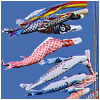
|

年中行事
- 日本の暦
- 六曜
- 松の内と小正月(1月)
- 節分(2月3日)
- バレンタインデー(2月14日)
- ひな祭り(3月3日)
- ホワイトデー(3月14日)
- 花見シーズン(3月-4月)
- 端午の節句(5月5日)
- 母の日(5月の第二日曜日)
- 父の日(6月の第三日曜日)
- 七夕(7月7日)
- 暑中見舞い
- お中元
- お盆
- 七五三(11月15日)
- クリスマス(12月25日)
- お歳暮
|

Many hina doll displays are quite large.
Photo from nsknet.or.jp.
Doll Festival (March 3)
The Doll Festival on March 3rd, also called Momo no Sekku (‘peach festival’), is the day to pray for girls to grow up safe and healthy. Families with daughters cerebrate this day by displaying hina dolls dressed like medieval courtiers, drinking sweet white sake, and eating rainbow-colored hina crackers. The first doll festival for a new baby girl, the hatsu sekku, is an occasion for special celebration.
The Doll Festival originates in jōshi no sekku, a seasonal ritual introduced from China. Traditionally, people would transfer the impurities accumulated in their bodies to a doll, and then release the doll, and their impurities, to float away down a river. The modern Doll Festival apparently started when this ceremony of purification was combined with the beautiful hina dolls that medieval court women played with. In some areas, people still conduct a nagashi bina
ceremony, in which they transfer their impurities to dolls and send them down a river.
|
|
|
| ポッドキャスト ダウンロード:
英語
| 日本語
|
|
文書 |
ビデオクリップ |
図表 |
写真 |
地図
|
|

